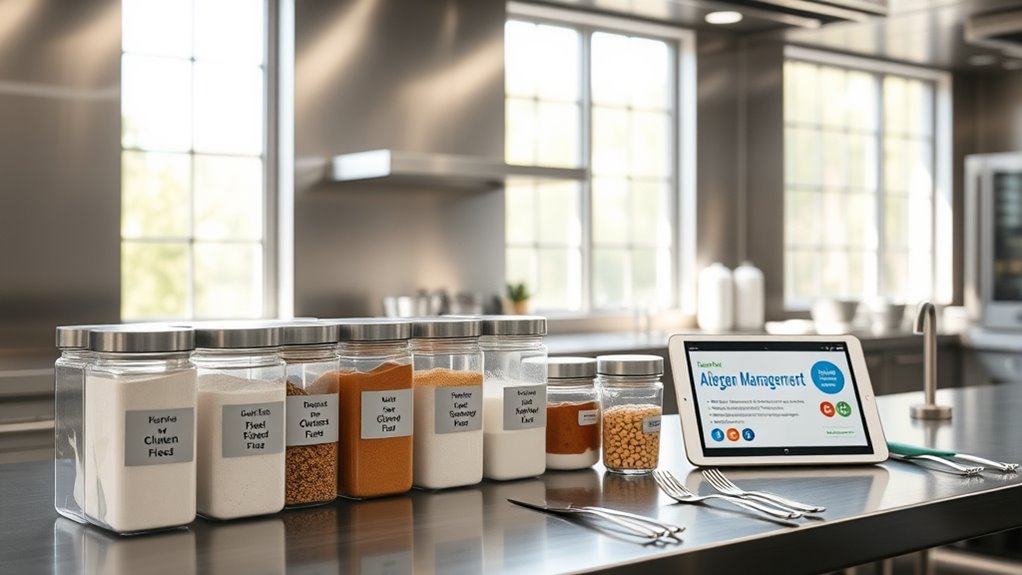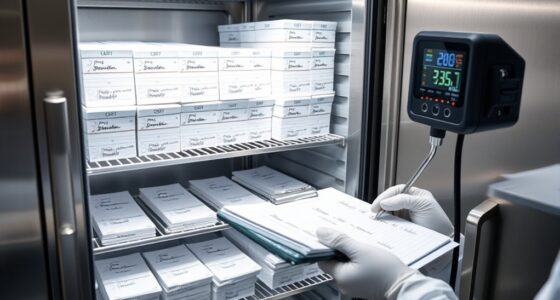To manage allergens effectively in a modern kitchen, you need clear policies, thorough staff training, and careful ingredient documentation. Organize your space to prevent cross-contact by using dedicated equipment, labeled storage, and segregated preparation areas. Communicate openly with customers about potential allergen risks and ensure proper handling procedures. Regularly monitor and record your practices, update protocols as needed, and stay informed about industry standards to keep everyone safe—there’s more to guarantee your kitchen’s allergen safety.
Key Takeaways
- Implement strict cleaning, dedicated tools, and proper storage to prevent cross-contact with allergens.
- Train staff regularly on allergen identification, handling, and sanitation procedures.
- Clearly label, segregate, and store allergen-containing ingredients separately to minimize accidental exposure.
- Maintain transparent ingredient documentation and communicate allergen information effectively to staff and customers.
- Design kitchen layouts that separate allergen-prone areas and utilize visual cues for allergen management.
Understanding Common Food Allergens and Cross-Contact Risks
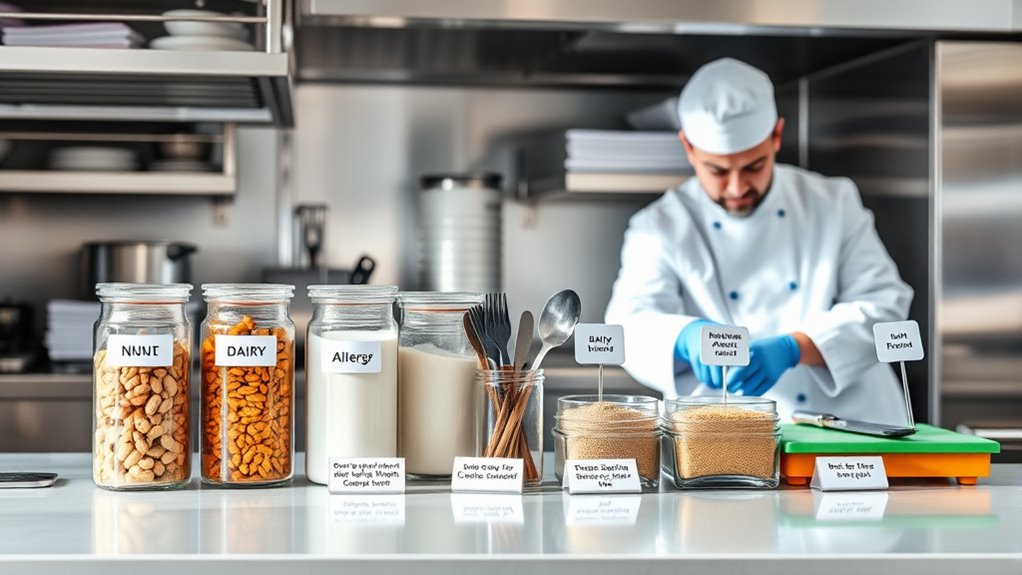
Understanding common food allergens and cross-contact risks is essential for effective allergen management. You need to recognize the top allergens, such as peanuts, tree nuts, shellfish, fish, milk, eggs, wheat, soy, and sesame, which cause most reactions. Cross-contact occurs when allergens transfer from one food to another through shared equipment, utensils, or surfaces. Even tiny traces can trigger serious reactions. To prevent this, you should implement strict cleaning procedures and use dedicated tools for allergen-containing ingredients. Be aware of hidden sources of allergens in processed foods and read labels carefully. Educate your staff about allergen risks and proper handling techniques. Regular cleaning of equipment and surfaces is crucial to minimize cross-contact and protect vulnerable individuals. Staying vigilant about allergens and cross-contact helps protect your customers and ensures a safer dining environment.
Developing Clear Allergen Policies and Procedures
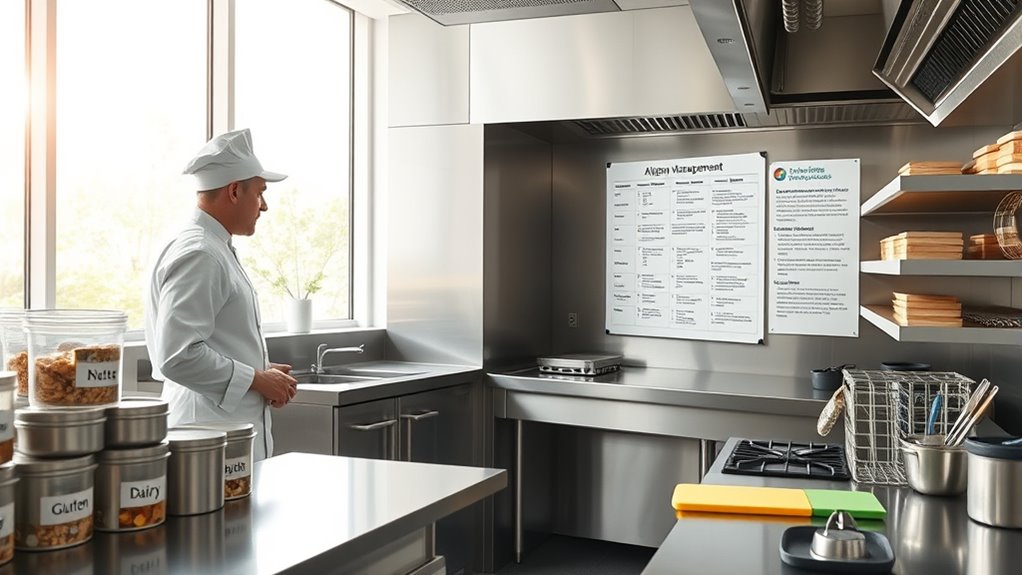
You need clear allergen policies that everyone can follow easily, so your documentation standards should be straightforward and consistent. Staff training strategies are essential to make certain your team understands and applies these procedures correctly. When you develop precise policies and effective training, you create a safer environment for all. Incorporating best practices for allergen management can further enhance your safety protocols.
Policy Documentation Standards
How can organizations guarantee their allergen management practices are effective and easily understood? The key is establishing clear documentation standards. Your policies should be precise, written in straightforward language, and consistently formatted. Use headings, numbered lists, and bullet points to organize information logically. Include definitions for technical terms, and specify responsibilities for staff at every level. Ensure procedures are step-by-step, detailing actions for allergen identification, handling, and cleaning. Regularly review and update documents to reflect changes in ingredients, equipment, or regulations. Store policies in accessible locations, both physically and digitally, so staff can easily reference them when needed. Clear, well-structured documentation builds trust, supports compliance, and minimizes the risk of allergen cross-contact.
Staff Training Strategies
Clear allergen policies and procedures are essential for guaranteeing staff can effectively manage allergens and protect vulnerable customers. To do this, you need to develop thorough training programs that cover allergen identification, cross-contact prevention, and proper labeling. Make sure your staff understands the importance of strict hygiene practices and the correct use of utensils and surfaces. Regularly reinforce training through refresher sessions and updates whenever policies change. Use practical demonstrations and real-life scenarios to enhance learning and retention. Encourage open communication so staff feel comfortable asking questions or reporting potential issues. By establishing clear, consistent training strategies, you ensure your team is knowledgeable, confident, and prepared to handle allergens safely, ultimately minimizing risks and safeguarding your customers’ health. Incorporating proper cleaning techniques into your training ensures that all surfaces and tools are sanitized effectively to prevent cross-contact.
Staff Training and Education on Allergen Management
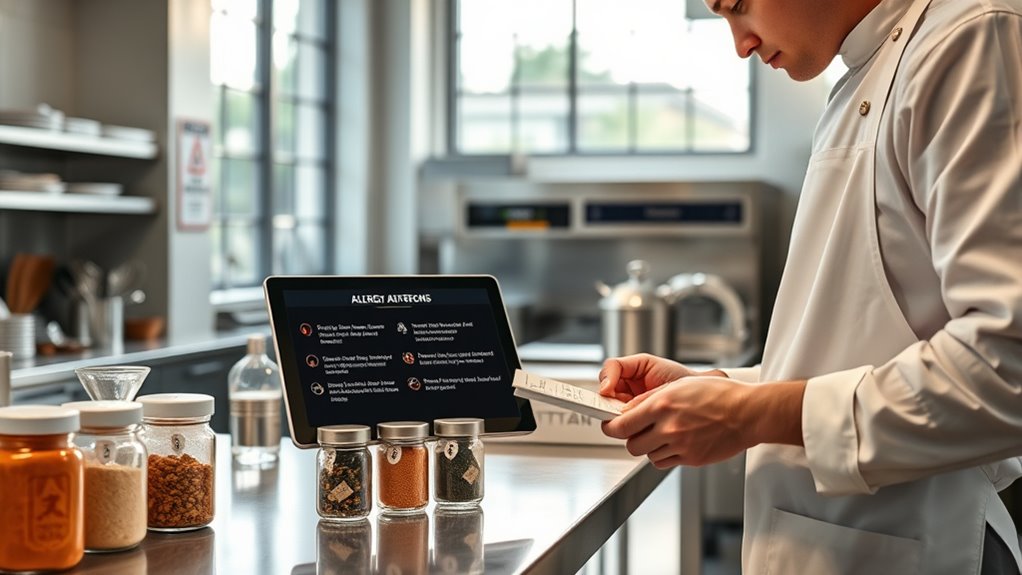
Effective allergen management depends heavily on well-trained staff who understand the importance of preventing cross-contact and accurately handling allergenic ingredients. You should ensure your team receives thorough training that covers allergen identification, safe storage, and proper cleaning procedures. Regular refresher courses help reinforce best practices and keep everyone up-to-date on new protocols. Encourage staff to ask questions and clarify any uncertainties about allergens to minimize mistakes. Use practical demonstrations and role-playing to enhance understanding. Clear communication is essential—everyone must know how to label, segregate, and prepare allergen-free dishes correctly. Proper training programs ensure staff are equipped with the necessary knowledge and skills to manage allergens effectively. When your team is educated and vigilant, it reduces the risk of accidental exposures, protecting your customers and maintaining your kitchen’s safety standards.
Ingredient Sourcing and Supplier Communication

You need to verify your suppliers thoroughly to guarantee they meet allergen safety standards. Clear, transparent documentation of ingredients helps you track potential cross-contact risks. Maintaining open communication with suppliers keeps your allergen management protocols effective and reliable. Staying informed about regulatory frameworks ensures your practices align with current safety requirements.
Supplier Verification Processes
Ensuring the safety of ingredients starts with thorough supplier verification processes, which are essential for maintaining allergen management standards. You need to establish clear criteria for selecting suppliers, focusing on their allergen control practices. Regularly review supplier certifications and audit reports to confirm compliance. Communicate your allergen requirements explicitly, and request detailed product specifications. Maintain open lines of communication to quickly address any issues or changes. Additionally, verify that suppliers have robust traceability systems to track ingredient origins. Here are key steps to strengthen your process:
- Confirm supplier certifications and audits
- Request detailed allergen information for each product
- Establish communication channels for ongoing updates
- Ensure traceability of ingredients from source to kitchen
- Conduct periodic supplier reviews and site visits
- Using industry trends can help you stay updated on best practices in allergen management.
Transparent Ingredient Documentation
Transparent ingredient documentation begins with clear communication and detailed sourcing information from your suppliers. You need to request exhaustive data on ingredient origins, processing methods, and potential cross-contact risks. Establish strong relationships with your suppliers to ensure they understand your allergen management goals. Regularly verify their documentation and ask for updated certificates or reports. Keep detailed records of ingredient sources, batch numbers, and supplier contacts to track any issues quickly. Communicate openly with your team about ingredient details and potential allergen concerns. This transparency helps prevent cross-contamination and ensures that everyone understands ingredient origins and safety measures. Incorporating sound scientific principles, such as understanding quorum sensing in bacterial behavior, can also inform better sanitation and contamination control practices. This transparency helps prevent cross-contamination and ensures that everyone understands ingredient origins and safety measures. By maintaining thorough documentation, you build trust with customers and create a safer, allergen-aware kitchen environment.
Kitchen Layout and Equipment Organization
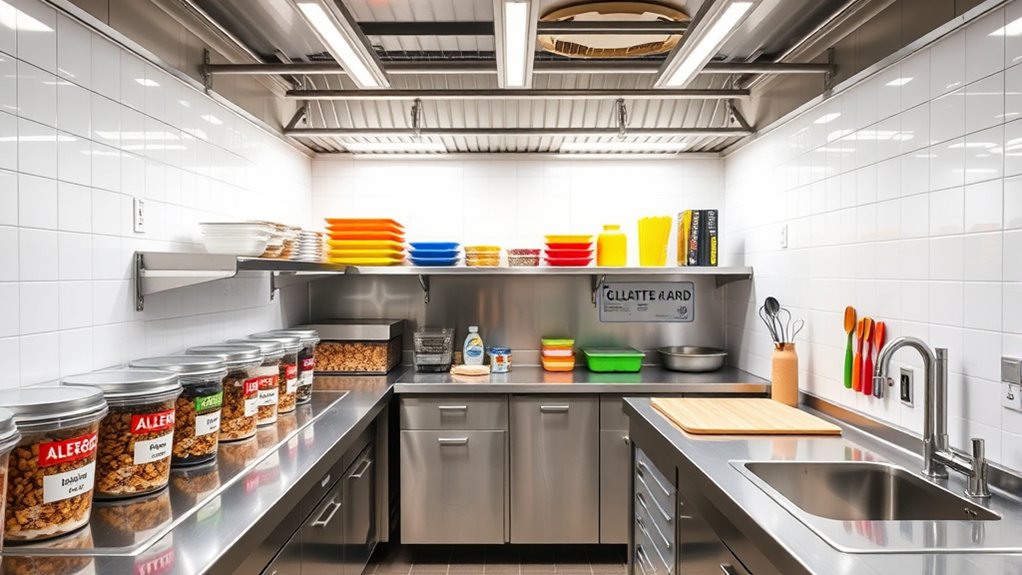
Have you ever considered how a well-organized kitchen layout can substantially reduce cross-contamination risks? Proper organization keeps allergen-prone ingredients separate and accessible. Position allergen-free foods away from raw meats and common allergens to prevent accidental contact. Use clearly labeled storage containers and designated areas for specific ingredients. Keep utensils, cutting boards, and cookware dedicated to particular allergens to avoid cross-contact. Additionally, arrange your workspace so that cleaning stations are easily accessible, encouraging regular sanitation. Consider creating zones within your kitchen: one for allergen-free prep, one for raw ingredients, and another for cleaning. This strategic layout simplifies allergen management and promotes safer food handling practices, ultimately protecting your customers and reducing the risk of allergen exposure. Incorporating advanced tools like AI-powered kitchen management systems can further enhance your ability to monitor and control allergen risks effectively.
Implementing Proper Food Preparation and Handling Techniques
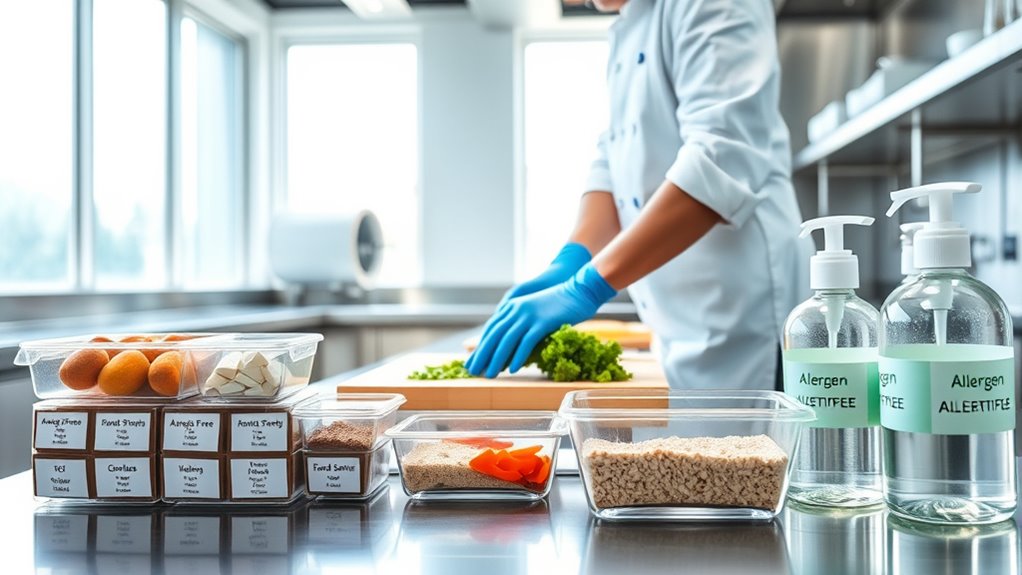
Proper food preparation and handling techniques are essential to maintaining a safe kitchen environment, especially when managing allergens. Always wash your hands thoroughly before touching any ingredients to prevent cross-contamination. Use separate cutting boards and utensils for allergen-containing foods and allergy-free items. Clean all surfaces and equipment after preparing each dish to eliminate residue. When cooking, avoid placing allergen-rich ingredients near allergen-free foods. Store raw meats separately from produce and ready-to-eat items. Be mindful of your workspace, keeping allergen ingredients confined to designated areas. Use gloves when handling allergenic products, and change them regularly. Additionally, understanding gelato flavors and their ingredients can help identify potential allergens and prevent accidental exposure. Consistency is key—following strict protocols helps prevent accidental exposure and ensures the safety of all diners. Proper handling safeguards both your kitchen’s integrity and your customers’ health.
Labeling, Storage, and Segregation of Allergen-Containing Items
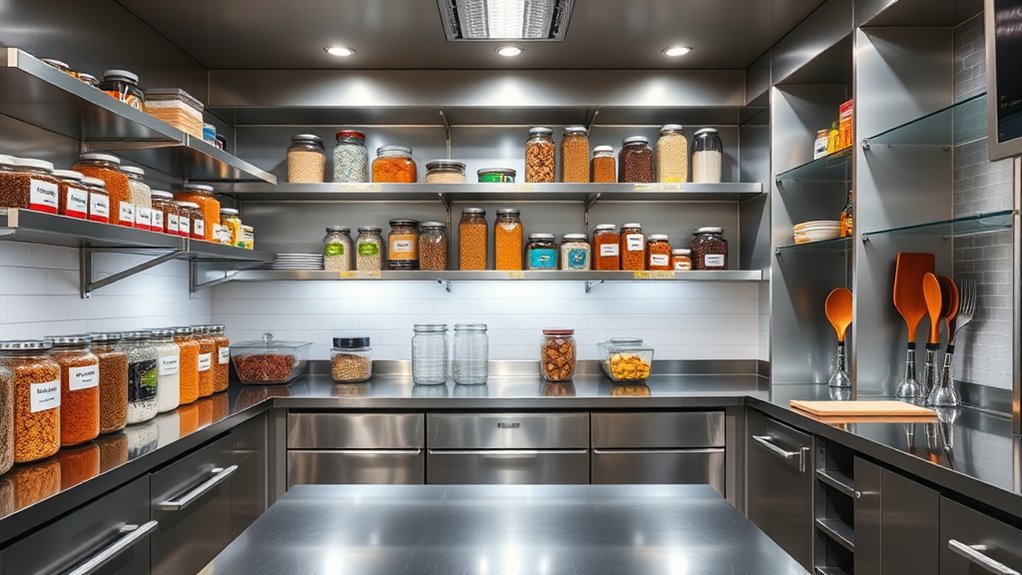
To effectively manage allergens in your kitchen, you need to clearly label all allergen-containing items and organize storage areas to prevent mix-ups. Proper labeling helps staff quickly identify allergen sources, reducing cross-contact risks. Store allergen-containing items separately from other ingredients, ideally in designated areas or containers. Segregate items using color-coded bins or labels to avoid confusion. Make certain that packaging is intact and clearly marked. Regularly update labels if ingredients change. Train staff to recognize and respect segregation protocols. Keep allergen items at the top or in clearly labeled zones, and avoid stacking them with non-allergenic products. Consistent organization minimizes accidental exposure. Additionally, implementing proper storage techniques ensures allergens are kept in secure, clearly designated areas, further reducing the risk of cross-contact. Remember, clear labeling and thoughtful storage are crucial to safeguarding allergen-sensitive customers and maintaining a safe kitchen environment.
Monitoring, Documentation, and Continuous Improvement
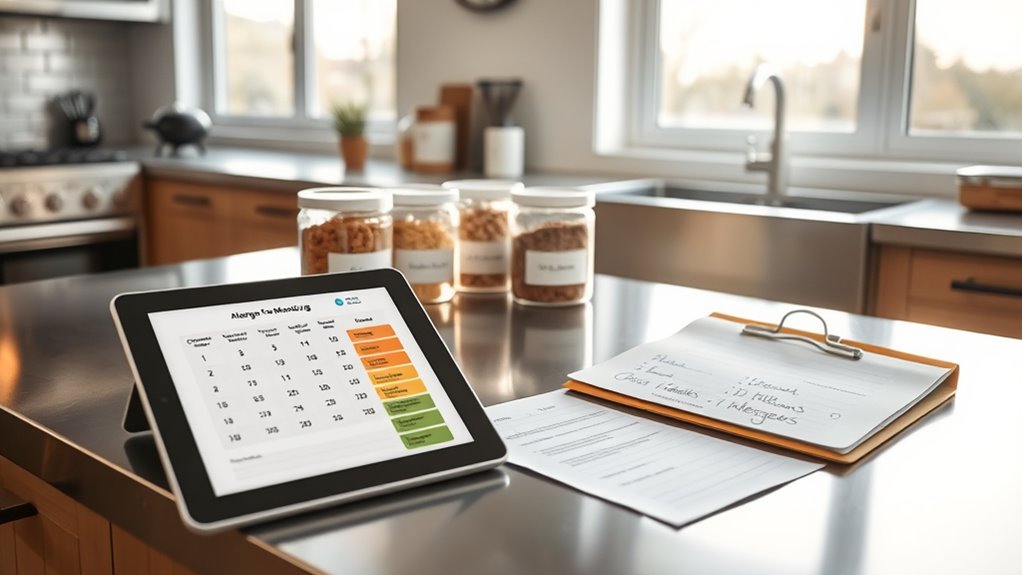
Implementing effective monitoring, documentation, and continuous improvement processes is essential for maintaining allergen safety in your kitchen. Regularly review your procedures to identify potential gaps or areas for enhancement. Keep detailed records of allergen incidents, cleaning schedules, and staff training sessions to track progress and accountability. Use this data to analyze trends and pinpoint recurring issues. Encourage a culture of continuous improvement by adapting protocols based on findings and industry best practices. Conduct routine audits to verify compliance with allergen management standards. Share lessons learned with your team to reinforce best practices. Consistent monitoring and documentation not only help prevent contamination but also demonstrate your commitment to allergen safety, fostering trust with customers and ensuring a safer dining environment.
Communicating Clearly With Customers About Allergens
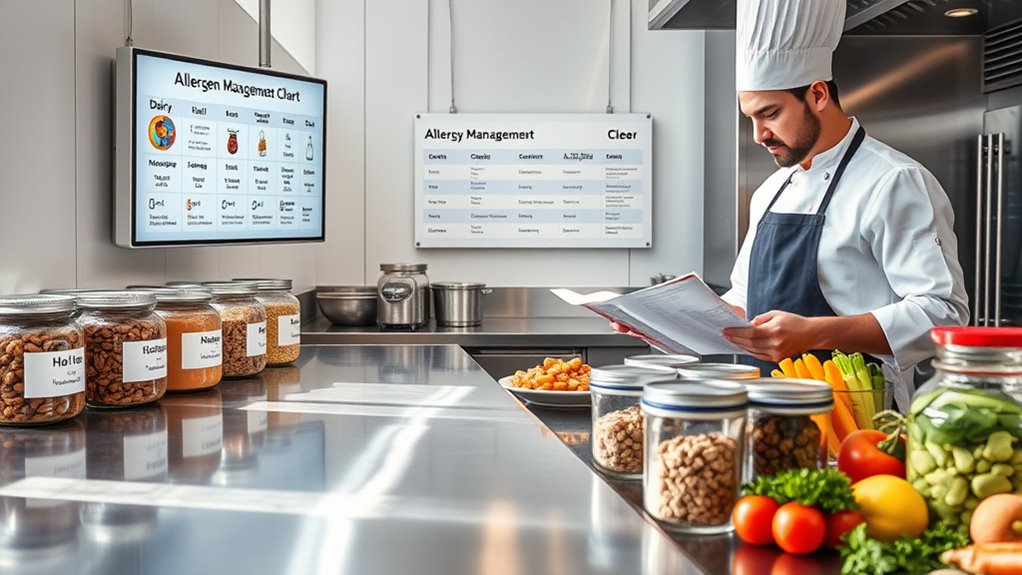
Clear communication with customers about allergens builds trust and helps prevent accidental exposures. You should be transparent about ingredient lists, allergen risks, and preparation methods. Use clear, simple language to guarantee customers understand the information. Always ask about allergies upfront and encourage questions. Display allergen information prominently and update it regularly. Train staff to communicate effectively and handle allergen-related inquiries confidently. Remember, honesty is key—never downplay allergen presence or risk. By openly sharing allergen details, you create a safer environment and demonstrate your commitment to customer well-being.
- Clearly label all menu items with allergen information
- Train staff to answer allergen questions accurately
- Encourage customers to disclose their allergies
- Use visual aids like icons or charts for clarity
- Regularly review and update communication practices
Frequently Asked Questions
How Often Should Allergen Management Protocols Be Reviewed and Updated?
You should review and update your allergen management protocols at least annually, or whenever there are changes in ingredients, suppliers, or staff. Regular reviews help guarantee ongoing safety and compliance with regulations. If new allergens are identified or processes change, update the protocols immediately. Staying proactive minimizes risks and protects your customers. Consistent updates demonstrate your commitment to safety and help maintain a trusted, allergen-aware environment in your kitchen.
What Are the Legal Requirements for Allergen Labeling in Restaurants?
Think of allergen labeling like a clear sign on a busy street—it’s essential for safety. Legally, you must accurately identify allergens on menus and packaging, following local regulations like the FDA Food Labeling Rule in the U.S. or EU directives. You’re responsible for ensuring labels are truthful, legible, and up-to-date. Failing to comply can lead to legal penalties and endanger your customers, so stay informed and diligent.
How Can Technology Assist in Allergen Tracking and Management?
Technology helps you manage allergens more effectively by offering digital tracking tools, such as inventory management systems, that monitor ingredients and flag potential cross-contact risks. You can use apps to record allergen information, ensuring accurate labeling and quick updates. Barcode scanners and data integration streamline communication between staff, reducing errors. Embracing these tools allows you to stay compliant, protect customers, and maintain high safety standards effortlessly.
What Are Best Practices for Handling Allergen Emergencies or Reactions?
You won’t believe how quickly an allergen emergency can escalate, so stay calm and act fast. First, identify the allergen and call for medical help immediately if symptoms worsen. Administer an epinephrine auto-injector if available, and keep the person comfortable while waiting for emergency services. Document the incident thoroughly, and review protocols afterward to prevent future reactions. Your quick, composed response can be life-saving.
How Do Cultural or Regional Differences Impact Allergen Management Strategies?
You need to recognize that cultural and regional differences affect how allergen management strategies are implemented. For example, some regions may have traditional dishes with common allergens, requiring tailored communication and ingredient labeling. You should adapt protocols to respect local practices while ensuring safety. By understanding these differences, you can develop effective, culturally sensitive strategies to prevent reactions and manage allergens appropriately in diverse culinary environments.
Conclusion
By following these allergen management protocols, you create a safer kitchen environment. Did you know that cross-contact causes up to 30% of food allergy reactions? Staying vigilant and implementing clear procedures not only protects your customers but also boosts your restaurant’s reputation. Keep training your staff, organizing your space, and communicating openly. Together, these steps reduce risks and guarantee everyone can enjoy your food with confidence.
